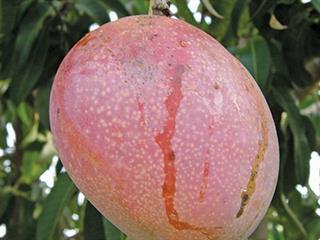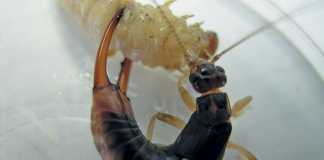
The gall fly (Procontarinia matteiana) is arguably the most destructive mango pest that SA farmers face. “The problem is very, very serious,” says Jamela Masekane, who runs a 0,8ha orchard in the prime Trichardtsdal area outside Tzaneen in Limpopo. ‘’Usually diseases mean the loss of just the fruit of the tree. With gall fly, you lose the fruit and leaves. In other words, the whole tree dies.’’
To emphasise the point, she points to a mango grove riddled with gaps and a tangled brown pile of dead tree leaves.
Mangoes flush twice a year – in spring and in early autumn. The autumn flush corresponds with gall fly emergence. The fly, a small midge of 1mm to 2mm, has become a growing concern in South Africa and many countries. It lays its eggs on the flush leaves of tree. These hatch into maggots that bore into the leaf tissue to feed, causing small, pimple-like galls to form. Mature maggots crawl out of the galls, creating small holes, and drop to the ground to pupate. The holes in the leaves then serve as entrances for fungal infections. The galls also destroy leaf tissue, and a heavy infestation can lead to premature leaf drop and reduced yield.
Towards a solution
A recent paper entitled The Application of Active Mango Metabolites for the Protection against Gall Fly Infestations looked at tissue development within true and pseudo-galls in order to provide insights into the role of secondary plant metabolites in arresting true gall formation. The research was carried out by Dr Wilma Augustyn from Tshwane University of Technology’s Department of Chemistry, Biotechnology and Food Technology.
The paper was presented for the first time at this year’s SA Mango Growers’ Association Mango Day on 6 August.
Augustyn says that high incidence of gall fly attack has been linked to attraction of the insect by volatile organic compounds emitted by the mango’s flush leaves. Mango cultivars present varying susceptibilities to gall fly infestation, with cultivars ranging from completely resistant to highly susceptible. Pseudo galls can form on those cultivars with intermediate susceptibility.
These cultivars are targeted by the gall fly, but secondary metabolites (substances produced by the normal metabolic reactions of the plant’s cells) within the leaves possibly halt the development, thereby preventing the development of true galls. Augustyn used three cultivars displaying varying susceptibility: Heidi, which typically is heavily infected; Keitt, which displays antixenosis properties; and Sensation, which is resistant to gall fly attack.
What the study revealed
Headspace profiles of the three cultivars were obtained over two full growing seasons. It was found that flush leaves emit higher levels of volatile organic compounds than mature leaves. Volatile emission peaked during the main flush, after which it declined as the tree went into the winter dormant period. According to Augustyn, the levels of α- and β-pinene increased in gall fly-susceptible cultivars as the season progressed, while resistant cultivars emitted very low levels of these terpenes.
The changes in the profiles of these emissions suggest that α- and β-pinene may be linked to gall fly susceptibility. Seven essential oils – aniseed, basil, clary sage, juniper berry, rosemary, sage and spearmint – that contain the three identified biomarkers α-pinene, β-pinene and camphene, were utilised as attractants.
“The ratios present in the oils did not correspond to those of the emitted volatiles from Heidi, a cultivar highly susceptible to gall fly infestation. Rosemary, which contained the ratio closest to that of Heidi, was supplemented with the components to attain the desired ratio,” Augustyn says.
During the study, these essential oils, as well as pure (-)-α-pinene, pure (-)-β-pinene, and the two pinenes in combination with camphene, were introduced in different concentrations to leaves enclosed in aluminium foil and plastic bags. “Although the rosemary oil and rosemary mixture did elicit the emergence of the gall flies, the best results were obtained with the (-)-α-pinene, (-)-β-pinene and camphene mixture,” Augustyn explains.
The volatile mixture was then absorbed on a slow-release gel and placed in Moroccan and McPhail traps in the orchard to determine if mass emergence of the gall fly could be induced. Only a few insects were trapped. The majority of these were the gall fly parasite, which lays its eggs inside the fly. These produce larvae that eat the fly.
The process was repeated with dichlorphos introduced in the traps to ensure that those insects that enter the trap remained inside. The volatile mix, added to water and a surfactant, was sprayed on three trees to determine if this form of application could serve as a trigger for gall fly emergence.
Investigations into slow-release trap placement, as well as orchard spray application, are still ongoing. Augustyn’s research also suggests that the insecticide Thiamethoxam may be effective in curbing the development of gall fly larvae.
The mango situation in SA
Mangoes are grown in the lowveld of Limpopo and Mpumalanga, with the highest concentration being in the Letaba District. Other mango-growing areas are Messina north of the Soutpansberg, Hoedspruit, Skukuza and Ofcolaco. About 60% of this production is processed, 30% is consumed locally as fresh fruit, and 10% is exported. In South Africa, mango trees suffered extensive damage from mango gall flies in the 1960s. Mango gall flies were also implicated in the transmission of the causal organism of bacterial black spot that colonise the galls.
Phone Dr Wilma Augustyn on 012 382 6127 or email at [email protected].













